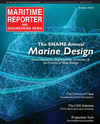
Page 40: of Maritime Reporter Magazine (October 2018)
Marine Design Annual
Read this page in Pdf, Flash or Html5 edition of October 2018 Maritime Reporter Magazine
nearly every position I held. When I ? rst workforce to use new software while to ensure they could build what was arrived at the company, ship designs maintaining production schedules. shown on the drawings. were still done by pen and ink. I was Looking back, it is gratifying to see one of the ? rst 10 people who learned so many of the technologies I helped Finally, when actual construction got how to use CADAM, the company’s ? rst introduce still in use or foundations of underway, the ship? tters would have computer-aided design software pack- continued advancement. to locate and ? x any remaining fouls age. I also spent nearly a decade work- and ? gure out the to-? t work. It took a ing on the company’s in-house 3D solid How has the industry evolved lot of skill and know-how to put every- modeling software VIVID which we used most dramatically? thing together. Now all the design and to design the SEAWOLF submarine. Shipbuilding goes back to the Phoeni- construction planning work is done in a cians and used to be considered a dirty single product model. Each discipline
Later, I managed the waterfront instal- and dangerous job. Shipbuilding today can see the others and downstream lation and production testing of our $40 is remarkably sophisticated. There is customers can walk through the design million robotic cutting and welding lines still a high level of expert craftsmanship, as it develops. What a difference!
called the Automated Steel Factory. and now it bene? ts from virtual tools,
During early development of the FORD augmented reality, robotics, and ad- How long have you been a mem-
Class aircraft carrier program, I worked vanced manufacturing technology. ber of SNAME? How did SNAME with our Innovation Center and the impact your career?
I’ve been a SNAME member for 35 years. My ? rst supervisor at the ship- yard recommended I get involved with “
SNAME as a way of building my profes- “I see a lot of fresh energy at SNAME. We’ve grown our sional network. Then he made sure I student sections and branched out internationally. The was appointed House Committee Chair maritime and offshore industries are truly international for the Hampton Roads Section, so I and projects in our ? eld span the globe, so it’s appropriate had to check in all meeting attendees that our professional society be global, too.” and got to know people quickly. He also occasionally asked me to review and comment on technical papers.
My favorite memories of those early
Navy to identify cost-saving technolo- What one technology do you be- SNAME years were the opportunities to gies for the new ship design. Then I lieve made the process of ship- rub elbows with senior company execu- had the chance to lead our Research & building more ef? cient? tives. Mr. Ed Campbell and Mr. Pat Phil-
Development organization for several From my experience, the 3D product lips were presidents of Newport News years, an exciting opportunity to explore model has been transformational in Shipbuilding; both also served terms as more innovations for our key product ship design and construction. It’s hard SNAME presidents, and they regularly lines and manufacturing processes. to believe now, but I remember when attended the local section meetings,
One project I’m particularly proud of is designers from each discipline – pip- too. It was great for a young engineer our pioneering use of immersive 3D vi- ing, mechanical, ventilation, etc. – were to meet company leaders and they also sualization to “walk through” and review basically working blindly in a space, got to see me take leadership roles at ship spaces before construction; our not knowing where the other designers the local level at a very young age. It design, planning, and construction folks were running their systems. was a good way to stand out from the all made use of it, as well as the Navy crowd and become recognized by man- customer. A skilled and experienced designer agement as a can-do person.
had to take all those systems, envi-
The last project I led before retiring sion them in space, and try to build a You are set to take over as was the company’s migration from one composite drawing of everything in the SNAME president in 2019, the computer toolset to another for design, compartment. It looked like spaghetti ? rst woman president of the planning, construction and lifecycle sup- and of course there were always fouls organization. Why did you want port. Just to make it a little tougher, we from systems running into each other. the job?
were also in the middle of Ford design Then the trades would build enormous SNAME has been my professional or- and construction at the time. We had full-scale wood and plastic mockups of ganization throughout my entire career. to migrate the entire ship design with the most signi? cant ship spaces (think: SNAME has provided many education near-perfect accuracy and re-train the whole submarine inside a building!) and leadership opportunities and is the 1916 1917 1933 1939
First ship-to-shore radio telephone Launching of battleship Commissioning Naval Research Lab voice conversation from USS New New Mexico (BB-40), of USS Ranger, recommends ? nancing
Hampshire off Virginia Capes ? rst capital ship ? rst true aircraft research program to ob- to SECNAV Josephus Daniels in with turbo-electric carrier tain power from uranium.
Washington, DC propulsion
Maritime Reporter & Engineering News, October 2018 th
SNAME 125 Anniversary Special 40
MR #10 (34-41).indd 40 MR #10 (34-41).indd 40 10/5/2018 10:07:17 AM10/5/2018 10:07:17 AM

 39
39

 41
41
